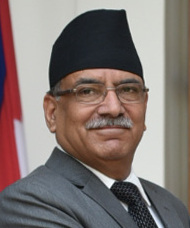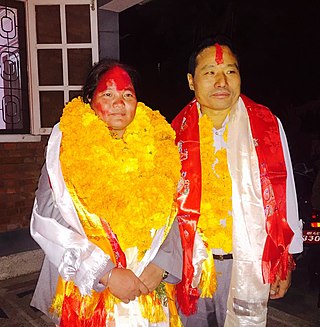
The politics of Nepal functions within the framework of a parliamentary republic with a multi-party system. Executive power is exercised by the Prime Minister and their cabinet, while legislative power is vested in the Parliament.

The Nepali Congress is the largest social democratic political party in Nepal. As per the results of recent local election, Nepali Congress stands as the single largest party of Nepal at all levels of government. It is the current main opposition party in Nepal since 26 December 2022. With more than one million active members, the party remains the largest party in Nepal by membership.

Pushpa Kamal Dahal, also widely known by his nom de guerre Prachanda, is a Nepalese politician serving as the current Prime Minister of Nepal. He previously held the prime ministerial post from 2008 to 2009, and again from 2016 to 2017.

Baburam Bhattarai, also known by his nom de guerre Laaldhwoj, is a Nepalese politician and former Prime Minister, who presently serves as leader of the Nepal Socialist Party.

The Communist Party of Nepal , abbreviated CPN , CPN-Maoist Centre, CPN Maoist Centre, or CPN (MC), is the third largest political party in Nepal. It was founded in 1994 after breaking away from the Communist Party of Nepal.

The Communist Party of Nepal is a communist political party in Nepal. The party emerged as one of the major parties in Nepal after the end of the Panchayat era.

Sher Bahadur Deuba is a Nepali politician and former prime minister of Nepal. He has also been serving as the president of the Nepali Congress since 2016. Deuba has served five terms as the prime minister and is the Member of Parliament for the parliamentary constituency of Dadeldhura 1.

Nepal Ratna Girija Prasad Koirala, affectionately known as Girija Babu, was a Nepalese politician. He headed the Nepali Congress and served as the Prime Minister of Nepal on four occasions, including from 1991 to 1994, 1998 to 1999, 2000 to 2001, and from 2006 to 2008. He was the Acting Head of State of Nepal between January 2007 and July 2008 as the country transitioned from a monarchy to a republic.

The 2006 Democracy Movement is a name given to the political agitations against the direct and undemocratic rule of King Gyanendra of Nepal. The movement is also sometimes referred to as Jana Andolan II, implying it being a second phase of the 1990 Jana Andolan.

The Nepal Communist Party, abbreviated NCP is a defunct communist party of Nepal. It was founded on 17 May 2018, from the unification of two leftist parties, Communist Party of Nepal and Communist Party of Nepal. The unification was completed by the Party Unification Coordination Committee, after eight months of negotiation. The two predecessor parties subsequently dissolved, making way for the new united party. The party retained the electoral symbol of the CPN (UML), the sun.

Bijaya Kumar Gachhadar is a Nepalese politician and leader of the Nepali Congress. He has served five terms as deputy prime minister of Nepal under the government of Madhav Kumar Nepal ,Baburam Bhattarai, KP Sharma Oli, Pushpa Kamal Dahal and Sher Bahadur Deuba. He was the second vice-president of Nepali Congress.

Khadga Prasad Sharma Oli is a Nepalese politician and former Prime Minister of Nepal. He served three terms as prime minister from 11 October 2015 to 3 August 2016, from 15 February 2018 to 13 May 2021 as the first elected prime minister under the new constitution, and from 13 May 2021 to 13 July 2021.
Constituent Assembly elections were held in Nepal on 19 November 2013. The vote was repeatedly delayed, having previously been planned for 22 November 2012 following the dissolution of the 1st Constituent Assembly on 27 May 2012, but it was put off by the election commission. The Nepali Congress emerged as the largest party in the 2nd Nepalese Constituent Assembly, winning 196 of the 575 elected seats.

Barsaman Pun, also known by his nom de guerre Ananta, is a Nepali communist politician and former Minister for Energy, Water Resources and Irrigation. He is also a member of the Standing Committee in Nepal Communist Party (NCP). He has previously served as Minister of Finance and Minister of Peace and Reconstruction. He was a leader of the Communist Party of Nepal (Maoist-Centre) during the insurgency period and served as one of 4 deputy commanders of People's Liberation Army.

Naya Shakti Party, Nepal was a democratic socialist political party in Nepal formed by former Prime Minister Baburam Bhattarai on 12 June 2016. On 6 May 2019, the party merged with Federal Socialist Forum, Nepal to form Samajbadi Party, Nepal.

The Unified Communist Party of Nepal , abbreviated UCPN (Maoist),, was a political party in Nepal. It was founded in 2009 after merging with minor Communist parties including the Janamorcha Nepal. On May 19, 2016, it merged with ten other breakaway factions and minor parties to form Communist Party of Nepal.

General elections were held in Nepal in two phases on 26 November and 7 December 2017 to elect the 275 members of the fifth House of Representatives, the lower house of the Federal Parliament of Nepal. The election was held alongside the first provincial elections for the seven provincial assemblies. A political deadlock between the governing Nepali Congress and the winning left-wing coalition over the system used to elect the upper house led to delay in forming the new government. Following the announcement of final result by the Election Commission, K.P. Oli of Communist Party of Nepal was sworn in as Prime Minister on 15 February 2018 by the President according to Article 76 (2) of the constitution. He passed a Motion of Confidence on 11 March 2018 with 208 votes.

On 7 June 2017, Sher Bahadur Deuba got elected as the new Prime Minister of Nepal and therefore formed the new Governmental Cabinet of Nepal Deuba's candidacy was supported by the Rastriya Prajatantra Party Nepal, the Rastriya Janata Party Nepal, the Nepal Loktantrik Forum, the Federal Socialist Forum, Nepal and several small parties represented in the Nepalese Parliament after a power-sharing deal with the Communist Party of Nepal, who also supported Deuba's candidacy. After being sworn in, Deuba formed a new government in a coalition with the parties that supported his election. On 17 October 2017, in preparation for the Nepalese legislative election, the Communist Party of Nepal decided to cooperate with the Communist Party of Nepal. For this, all of their ministers left the cabinet after Prime Minister Deuba was prepared to dismiss them.

The Second Oli cabinet was the Government of Nepal from 15 February 2018 to 13 July 2021. It was initially formed as a majority coalition on 15 February 2018, after Khadga Prasad Sharma Oli was elected as the new Prime Minister of Nepal following the 2017 general election. Oli's candidacy was supported by the Communist Party of Nepal and the Communist Party of Nepal. He assumed his office along with two ministers with the remaining ministers added at later points. The CPN withdrew its support from the government in May 2021, reducing it to a minority, and after the dissolution of the House of Representatives, it turned into an interim government. The second Oli cabinet was replaced by the fifth Deuba cabinet, formed after the Supreme Court ordered the appointment of Nepali Congress president Sher Bahadur Deuba as prime minister under in accordance with Article 76 (5) of the Constitution of Nepal.

General elections were held in Nepal on 20 November 2022 to elect the 275 members of the House of Representatives. There were two ballots in the election; one to elect 165 members from single-member constituencies via FPTP, and the other to elect the remaining 110 members from a single nation-wide constituency via party-list proportional representation.





















